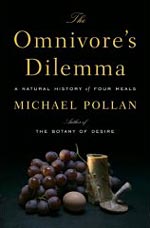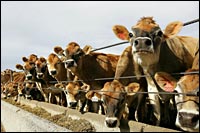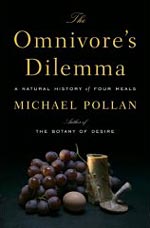In The Omnivore’s Dilemma: A Natural History of Four Meals, Michael Pollan diagnoses the national attitude toward food: angst.

The Omnivore’s Dilemma: A
Natural History of Four Meals,
by Michael Pollan, Penguin
Press, 320 pgs, 2006.
Channeling the modern middle-class shopper wandering vast supermarket aisles, Pollan asks: “The organic apple or the conventional? And if organic, the local or the imported? The wild fish or the farmed? The transfats or the butter or the ‘not butter’? Shall I be a carnivore or a vegetarian? And if a vegetarian, a lacto-vegetarian or a vegan?”
In Pollan’s view, our legacy as an immigrant nation without a central culinary tradition has damned the U.S. to a rudderless ride through the supermarket sea. We cast this way and that, battered by changes in scientific consensus and the food industry’s marketing schemes. “A country with a stable culture of food would not shell out millions for the quackery (or common sense) of a new diet book every January,” he writes. In France and Italy, by contrast, people “decide their dinner questions on the basis of such quaint and unscientific criteria as pleasure and tradition, eat all manner of ‘unhealthy’ foods, and lo and behold, wind up actually healthier and happier in their eating than we are.”
What we’re left with — 10,000 years of agriculture notwithstanding — is an atavistic return of the “omnivore’s dilemma.” Apes in the woods all over again, Americans grope to figure out what’s good to eat. Pollan seeks to provide a guide. He argues that our confusion about food stems from alienation: We don’t know what to eat because we’ve forgotten where food comes from.
To remind us, Pollan traces the various food chains that “link us … to the fertility of the earth and the energy of the sun.” In essays culminating in the “four meals” of the title, he shines a bright light on such obscure and important sites of U.S. food production as Iowa cornfields and Kansas feedlots; he investigates conditions on the big “organic” farms that supply Whole Foods with its dizzying and high-priced bounty; he explores the potential — and difficulties — of re-creating local and sustainable food networks by visiting an innovative Virginia farm; and he takes to the woods, at times packing a gun, in search of his own “hunter-gatherer” fare.
The project is valuable, and overdue. While Pollan’s critique of industrial food will be familiar to anyone who has studied food politics, his discussion of the alternatives — which he terms “industrial organic” and “beyond organic” — are original and provocative. (These sections lean heavily on material Pollan published previously in The New York Times Magazine.) But the main contribution of Omnivore’s Dilemma is its scope and rigor. I know of no other book that delivers a broader picture of the U.S. food scene, how it got the way it is, and how it’s changing.
Bastard Children of the Corn
If Pollan’s take on industrial food largely echoes authors such as Marion Nestle, Richard Manning, and Greg Critser, it also displays his quirky insights and ability to synthesize scientific concepts for a lay audience. He turns a naturalist’s eye on the supermarket — that “landscape (man-made, it’s true) teeming with plants and animals.” The startling, and largely illusory, biodiversity on display leads him to a pretty good working definition of industrial food: “Any food whose provenance is so complex or obscure that it requires an expert to help ascertain.”

Turns out you are what you eat.
Like other critics of industrial food, Pollan seizes on corn — the most heavily subsidized and prolific U.S. crop — as the example par excellence of a food system gone rancid. “There are some 45,000 items in the average American supermarket, and more than a quarter of them contain corn,” he reports. Indeed, corn and its array of byproducts have so successfully colonized the U.S. diet — and so dominate the diets of the animals consumed here — that Americans have ripped the title of “the corn people” from Mexico, where corn was originally domesticated and remains a staple. Because of corn’s rare carbon signature, Pollan writes, it’s possible to discern from flesh or hair samples how much corn contributes to the formation of human bodies. “When you look at the isotope ratios, [U.S. residents] are corn chips with legs,” a biologist tells him.
From there, Pollan discusses the vexed economics of commodity agriculture with a beleaguered Iowa corn farmer and monitors the development of a calf from an idyllic pasture in South Dakota through its harrowing stay on a Kansas feedlot to its inglorious end. This facet, the plight of feedlot cows, merits special attention. The animals evolved to eat grass, but three-quarters of a feedlot cow’s calories come from corn — and the rest from stuff the meat industry does not want you to think about. While the mad-cow scare forced the FDA to ban the practice of feeding rendered beef and bone tissue to cows in 1997, feedlot cows — those mistreated herbivores — still practice cannibalism as a matter of course. The FDA ban only extended to protein; feedlot operators can and do use cow blood and fat products.

When the going gets trough.
Photo: iStockphoto.
Cows eat other meat products as well. “Feather meal and chicken litter (that is, bedding, feces, and discarded bits of feed) are accepted cattle feeds, as are chicken, fish, and pig meal,” Pollan reports. Worse, “since the bovine meat and bonemeal that cows used to eat is now being fed to chickens, pigs, and fish, infectious prions could find their way back to cattle when they’re fed the protein of the animals that have been eating them.”
Yet for all the nightmarish stuff feedlot cows eat, the most damaging of all may be their staple, corn, which tends to damage their livers. Evidently, corn-fed cows become sick as a matter of course, a fact accepted by the industry as a cost of doing business. “Between 15 and 30 percent of feedlot cows are found at slaughter to have abscessed livers,” Pollan writes. Big Mac, anyone?
Splenda in the Grass
In probably the most important section of Omnivore’s Dilemma, Pollan describes what might be called the industrial-organic complex: the large-scale farms and food-processing outfits that largely satisfy surging demand for organic food. The author uses Whole Foods as a proxy for the industrial-organic ethos. He writes: “‘Organic’ on the label conjures up a rich narrative … supplying the hero (American family farmer), the villain (agribusinessman), and the literary genre, which I’ve come to think of as supermarket pastoral.” For Pollan, the marketing geniuses at Whole Foods peddle an irresistible commodity: self-satisfaction. He quotes a marketing consultant waxing creepily about how the store offers consumers the opportunity to “engage in authentic experiences” and “return to a utopian past with positive aspects of modernity intact.”
Yet the virtues on sale often prove spectral, Pollan shows. The “free-range” chicken on offer, it turns out, hails from a confinement operation with a tiny yard, largely unused by the short-lived birds. And after giving gigantic organic vegetable outfits a long and sympathetic hearing, he subjects them to a devastating energy analysis. Pollan finds that while a one-pound box of California-produced organic lettuce contains 80 food calories, it requires 4,600 calories of fossil fuel to process and ship to the East Coast. He adds that the figure would be only “about 4 percent higher if the salad were grown conventionally.” It’s hard to dispute Pollan’s assessment of large-scale organic agriculture: it’s “floating on a sinking sea of petroleum.”
In contrast to the marketing geniuses who now dominate organic food, Pollan presents Joel Salatin, a loquacious farmer who runs a successful midsized, multispecies meat farm in Virginia. While large-scale organic operations function essentially in a global economy — leaning heavily on off-farm inputs, growing for markets thousands of miles away, relying on disenfranchised immigrant labor — Salatin insists on selling his goods close by and relying on his family and a few interns to supplement his labor.
Pollan’s account of his week with Salatin captures the paradoxes of life on a bustling, successful, integrated farm: the incessant backbreaking work, the brutally early mornings, the addictive beauty of a dewy field at dawn, the fresh, alive flavor of food you can’t get anywhere else. He presents Salatin’s style as a way forward, but not a panacea: “My guess is that there aren’t too many farmers today who are up for either the physical or the mental challenge of this sort of farming, not when industrializing promises to simplify the job.”
For its many virtues, this book contains some flaws. Pollan can be a windy writer; he occasionally indulges in long first-person asides that dilute his arguments. And the final section, a long account of a meal Pollan foraged for himself, seems a bit tacked on. Hunting and gathering is an interesting topic — and as always Pollan packs plenty of useful information into the chapter. But unlike the other food chains he traces, foraging is hardly a significant source of calories in the United States — and it will require a doomsday scenario to make it so. (Manning ended 2004’s Against the Grain on a similar note. What is it about food politics that sends male writers of a certain age skulking through the woods with a gun, looking for something to kill?)
But this is an important book, sweeping through broad ground with impressive primary and secondary research. The annotated “Sources” list alone is required reading for anyone interested in food politics. Pollan presents no easy answers, but loads of provocative analysis. As the industrial-food machine lurches on and organic agriculture increasingly scales up to meet the demands of big retailers, Pollan wants to remind people that “we eat by the grace of nature, not of industry, and what we’re eating is never anything more or less than the body of the world.”



